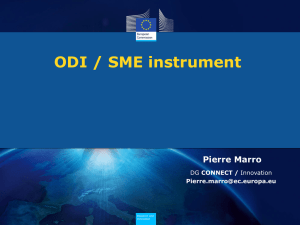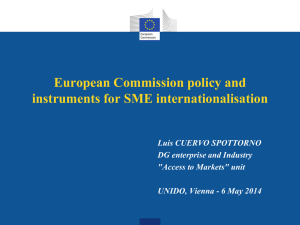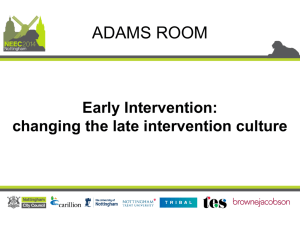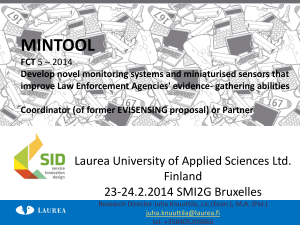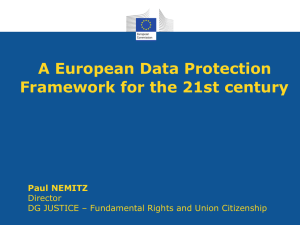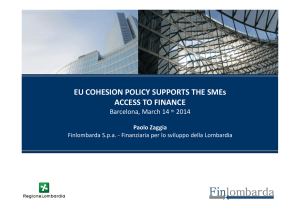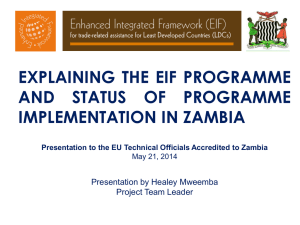Ioannis Tsakiris - Assembly of European Regions
advertisement
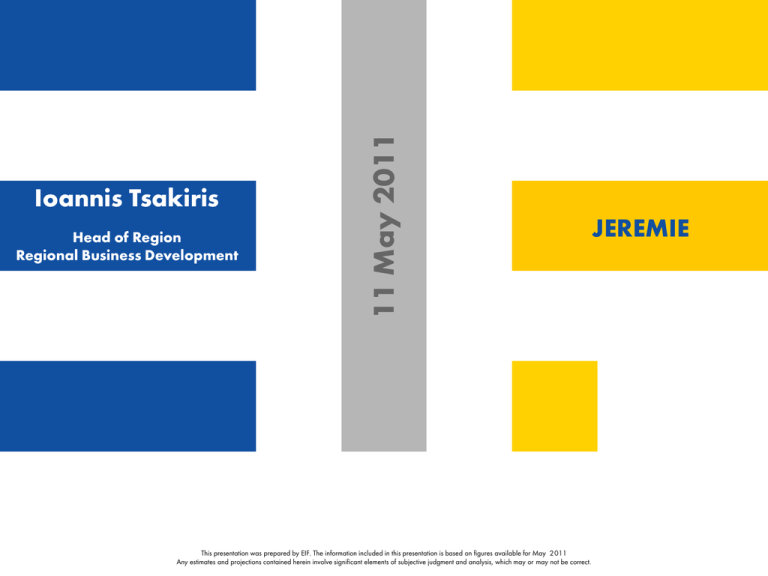
Head of Region Regional Business Development 11 May 2011 Ioannis Tsakiris This presentation was prepared by EIF. The information included in this presentation is based on figures available for May 2011 Any estimates and projections contained herein involve significant elements of subjective judgment and analysis, which may or may not be correct. JEREMIE EIF at a glance 1 / 23 EIF - The Challenge: Financing Innovation amongst SMEs in Europe SMEs account for a large proportion of Europe’s economic activity Micro-businesses dominate employment in countries such as Italy (48%) and Greece (57%) Successive EU summits put issues of growth, employment, innovation and competitiveness high on agenda Support to SMEs: one of the top six EIB Group priorities EIF is the SME risk financing arm of Source: Eurostat, Commission Communication on Modern SME policy for Growth and Employment the EIB Group 2 / 23 Importance of SMEs as the Foundation Stone for Tomorrow’s Prosperity EIF at a Glance EU specialised institution for SMEs, risk financing Venture Capital and Mezzanine (fund of funds) Structuring and Guaranteeing portfolios of SME and microfinance loans/leases Geographic Focus / Intermediaries EU 27, EFTA, Candidate Countries Distributing through Banks and Funds Authorised Capital € 3bn EIB: 61.2% EU: 30 % Fin. institutions: 8.8 % AAA rated Staffing, Culture and Values Leading-edge modern institution Adapting to changing market conditions Attracting talented staff High standards of compliance and integrity 3 / 23 Dual Objective of Meeting EU Policy Goals & Generating a Satisfactory Return on Equity Operating Model of EIF Transformational Role of EIF Suppliers / Mandators Own resources EIB (RCM, MEZ) EC (CIP) MA (JEREMIE) MS (ERP) Funds of Funds Regional (LfA) Transformational Key Success Factors Product Development Commercial Banks Mandate Management Development & Transaction Execution Promotional Banks Risk Management Guarantee Institutions Follow-up & Fund Managers Relationship Focus VALUE ADDED 4 / 23 Intermediaries SMEs JEREMIE Holding Funds in support of SMEs 5 / 23 JEREMIE: Increasing the Deployment of Self-Sustaining Financial Instruments for SMEs The Joint European Resources for Micro to Medium Enterprises Joint initiative of the EU (DG Regio & EIB Group) launched in October 2005 Joint also because it potentially combines resources from the EU, National Public Authorities, EIF, EIB and/or other financial institutions Participation in JEREMIE optional for each country/region – Holding Fund Management Uses European Regional Development Funds or European Social Funds for enhancing SME access to finance in New Member States and in Regional Development areas through sustainable and “revolving” financial instruments Create and foster entrepreneurship in Europe EVALUATION 6 / 23 2006 IMPLEMENTATION JEREMIE Phases DISBURSEMENT PROCESS 2013 Why JEREMIE? Use ERDF/ESF to improve SME access to finance; Reduce the practice of “grant financing”; Increase the flexibility of financial engineering instruments by making them permanent and ”revolving”; Leverage effect: try to attract other sources of funding (BEI, national funds, regional funds, banks, etc.); The concept of Holding Fund: a new idea, at the root of JEREMIE; HF provides funds to Financial Intermediaries which operate in the relevant market segments: VC, guarantees, micro-credit, etc...; Simplified procedures, thanks to HF concept; Delegation of the selection of the Financial Intermediaries and the monitoring and the reporting to Commission to an independent external expert, Allocation of funds to a series of financial instruments To support SMEs throughout the lifecycle 7 / 23 Reallocation of funds within the Holding Fund at any time EU Level Managing Authority 8 / 23 Regional /Local Level National/regional /Local Level European Commission ERDF – DG Regio National /or regional Level Key Structural Benefit: Funds Allocated Upfront to Fund Holder and Managed at Local Level Disbursement Up front Irreversible Local holding fund Greater delegation to Local Holding Fund (« HF ») HF Manager Role of the HF Manager Structure investments, select Financial intermediaries SMEs Authorities Management/administration are outsourced to HF Mgr. Financial Intermediaries Administer, monitor & report on investments Attract a syndicate of investors Closely collaborate with national/regional authorities Microfinance beneficiaries THE MANAGER IS SELECTED BY MEMBER STATE/REGION EIF Tool Kit for SMEs Public Stock Markets SME Cash Flows Funded Risk Sharing for SMEs Portfolio Guarantees & Credit Enhancement Formal VC Funds & Mezzanine Funds Funded Risk Sharing for SMEs VC Seed & Early Stage Microcredit Business Angels, TT Pre-seed Phase Seed Phase Start-up Phase Emerging Growth Development SME Development Stages HIGHER RISK 9 / 23 LOWER RISK JEREMIE Holding Funds 10 / 23 The JEREMIE process 11 / 23 JEREMIE Process: call for expression of interest Call deadline Progress Q & A process Publication State aid assessment Inv. Board approval Selection criteria Internal approval Instrument design Fact finding 12 / 23 Ensuring answers are communicated to all Website and other media to ensure market awareness Formal state aid assessment by competent local authorities Full presentation of product and call documents to local IBs Monitoring committee’s approval of a specific selection criteria Internal review and approval process including specialists from legal, risk management & compliance Expert driven process to specify product details, to meet market needs whilst respecting regulations Follow-on from gap analysis, discussions with key market players and associations Process JEREMIE Process: selection and approval Communication of decision Progress Board submission/approval Draft board report Due diligence Final Selection Set up of due diligence Pre-selection phase Selection Panel Eligibility check To FI, mandator and media as appropriate Proposal presented to EIF Board for approval Preparation of decision documents reviewed by all depts. Short-listed applicants undergo intensive 2 day interview process Presentation of FIs to DD team in loco, scores reviewed & minuted Invitations to 2nd screening issued & DD team formalised Desk-based review of submitted documents with initial scoring (QAC) and then team review (minuted) Internal agreement of members and observers of core selection team Initial check to ensure ‘EoI’ passes eligibility checklist with support of compliance Call deadline 13 / 23 Process Outcome of the JEREMIE process to date 70 Guarantee applications received 121 VC applications received 42 Due Diligences carried out 31 approved transactions 14 / 23 • Greece • Romania • Latvia • Lithuania • Slovakia • Languedoc Roussillon (FR) • Campania (IT) • Cyprus • Bulgaria • Sicily (IT) • Malta Holding Funds Portfolio Mix (in %) 15 / 23 Funded Risk Sharing Product (FRSP) Microcredit Guarantees Other Equity Risk Capital Fund Flexible non-allocated funds Amount of Private Finance Attracted 3500m 3000m 2500m 2000m 1,978 1,547 1500m 1000m 842 624 500m 0m 1,008 75 HFs 211 HFs 229 241 HFs HFs HFs HFs HFs HFs HFs Q4 2009 Q1 2010 Q2 2010 Q3 2010 Q4 2010 Q1 2011 Q2 2011 Q3 2011 Q4 2011 16 / 23 JEREMIE mandates & their financial engineering products 17 / 23 Case Study : JEREMIE via ERDF in LanguedocRoussillon (FR) market analysis : main conclusions Debt: Smaller funding, typically trough “loans”, for small projects concerning the creation of innovative SMEs with good potential. Such financing, which ensures a link with regional venture capital funds, is extremely limited in L-R. Equity: Funding through equity for the creation of enterprises: local intermediaries tend to move further away from this area of financing to focus investment activity on growth and development of enterprises. This failure is noticed for the creation of innovative enterprises. 18 / 23 JEREMIE Funding Agreement signed for LR Signature: 22 October 2008 Size: EUR 30m in 3 instalments: EUR 11m in 2008, EUR 10m in 2009 and EUR 9m in 2010 Duration: until 31 December 2015 Governance/Management: EIF = responsibility for JHF operations “Comité de Pilotage” (Investment Board) consisting of representatives of the French State and of the L-R Region with an advisory role and responsibility for the supervision of the operations – the 1st meeting took place in December 2008, and bi-monthly meetings have taken place thereafter. EIF = observer status 19 / 23 Languedoc-Roussillon financial instruments Languedoc-Roussillon is characterised by 3 types of financial engineering instruments Seed loans: interest-free loans (up to EUR 100,000) for SMEs operating in innovative sectors Co-investment fund: technology-oriented and innovative SMEs, participation in the equity of the SMEs of up to EUR 2.5m Guarantee: this product can be applied widely, with a minimum leverage effect of x8.4 and better terms for the SMEs (reduction of personal guarantee + interest rate reduction) Financial Intermediaries for all 3 financial products selected 20 / 23 What has the JEREMIE initiative brought to the Languedoc-Roussillon authorities? A better understanding of financial engineering. EIF has defined all the three instruments (seed loans, Co-investment, Guarantee), however the LR authority has been heavily involved since the beginning in the process. Encouragement to move away from grant-dependency to a revolving approach. With a grant approach, there is no leverage. However with the implementation of JEREMIE LR, the EUR 30m (50% ERDF, 50% Region LR) will be leveraged into EUR 143 m that will facilitate SMEs access to finance. JEREMIE in LR does not only benefit SMEs but also the LR economy as a whole. Prioritisation of actions to be implemented in order to develop the SMEs. In other words, instead of various initiatives (which may be difficult to follow and monitor, leading to fragmentation of leverage), the JEREMIE initiative will focus all efforts on one accurate target –thus reinforcing the competitiveness of this target (e.g. SMEs with a significant innovative component). 21 / 23 What has the JEREMIE initiative brought to the Languedoc-Roussillon authorities? Facilitates the monitoring of selected financial intermediaries. So far, it was not easy for the LR authority to monitor financial intermediaries (time consuming, lack of knowledge, etc.). Thanks to JEREMIE (under EIF) the LR authority was able to outsource the management of the reporting documents to the EIF Encourages to extention of concept to other sources of EU funding (for the next programming period) So far, JEREMIE has been implemented through ERDF. Due to the aforementioned benefits, the LR authority would like to carry out JEREMIE with EARDF and ESF source of funding during 2014-2020 22 / 23 Contact European Investment Fund 96 boulevard Konrad Adenauer L-2968 Luxembourg Tel.: (+352) 42 66 881 Fax: (+352) 42 66 88 200 www.eif.org 23 / 23





